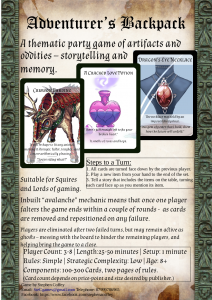So, for today I’m going to be looking at the sell-sheet for our main current card-game project, it design and a breakdown of what we’ve put in there.
This is not a how-to guide – it’s a how-I-did log: much of it is being written as the process is ongoing.
Step One: Look for Advice
I’ll start by linking a how-to guide, because that’s where I started on making the sheet.
Step Two: The Base Statistics of the Game:
How long does it take to play?
That varies, of course, but with timed playtests we’ve determined that it lasted 20-60 minutes. With a few minor rules adjustments, to allow compensating for player count and experience, it fits in the range of 25-50 minutes. Still a large variance, but not quite as extreme, and something that may be reducible further – but sell-sheets need to reflect the game as-is, not as-desired: a publisher won’t look kindly on a designer who deceives them from first interaction!
How many players can it take?
For Adventurer’s Backpack that’s a hard one to answer – technically it could be played with 20 players with no need to change the rules – but it would just be frustrating at that point. Deciding a cut-off for “How fun is fun enough” is necessarily arbitrary, but we went with a max of 8 players because we’ve been unable to playtest with 9 enough to say for sure, and 11 players is certainly no longer fun.
On the other end, it’s technically possible to play Adventurer’s Backpack solo – as a simple memory game – but it loses its greatest strength, the way that storytelling aids and influences memory! With two players the game works, but to my mind lacks most of its charm – so 3-8 it is.
What age is it for?
This one I actually missed out at first – a clerical error that I’ve just corrected. From our testing, some children as young as 6 may have fun with the game, but the combination of structured gameplay and freeform storytelling doesn’t always sink through – while we’ve only had a few playtests with children we believe that from age 8 most children will be able to grasp the game.
What components does it need?
It’s easy to forget this one – it doesn’t go on the outside of the game box like the others – but it’s absolutely vital. When it comes to mass-producing a game the materials needed and the manufacturing costs are vital – if the game is too expensive to make, then it’s not worth making; the more expensive it is the more it has to be able to grab its audience!
And Another Thing…
While not part of the standard set, I chose to include two/three further “stats” with those core ones:
Setup time – Most of our games are very quick to set up, and long set-ups can get frustrating, so keeping that clear in the core facts is valuable.
Rules and Strategic Complexity: The age range for a game is often used as a rough-and-ready guide to this, but the two can be very different – take Cards Against Humanity: it’s rules complexity is low, and its strategic complexity is zero, but it’s still at least a 12+ on age.

